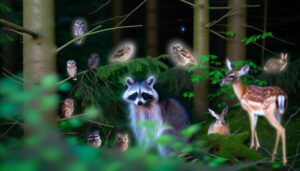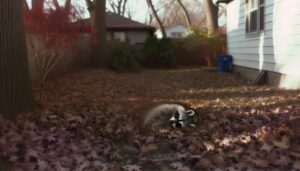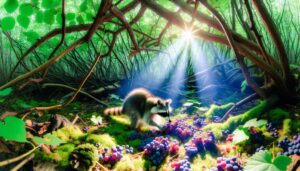How Do Raccoons Mate With Their Siblings?
Raccoons typically avoid mating with their siblings because of natural inbreeding prevention mechanisms. These include kin recognition, which helps them identify and avoid relatives, and dispersal behaviors, where juveniles leave their birth area to find new territories.
Territoriality also plays a role, as males expand their home ranges during mating season to locate unrelated females. These behaviors collectively reduce the risk of inbreeding, thereby maintaining genetic diversity and overall health in raccoon populations.
To grasp the full spectrum of their mating strategies and the impact of environmental factors, further details are essential.
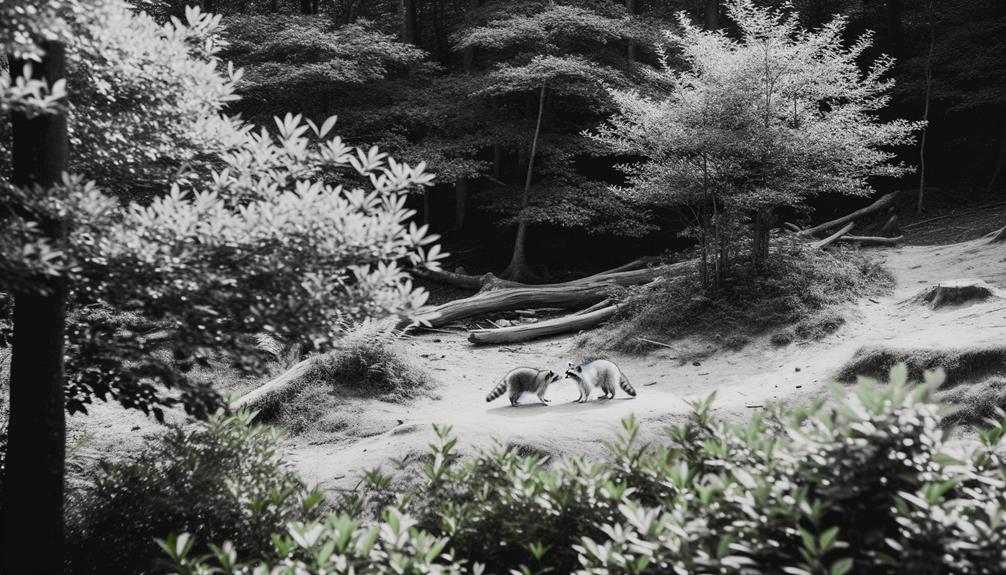
Key Takeaways
- Inbreeding prevention mechanisms like kin recognition help raccoons avoid mating with siblings.
- Juvenile dispersal reduces the likelihood of sibling mating by spreading out genetic material.
- Sibling interaction mainly involves play-fighting and foraging, not mating.
- Habitat fragmentation in urban areas can increase the risk of inbreeding among raccoons.
- Polygynous mating systems and varied genetic contributions reduce the chances of sibling mating.
Raccoon Mating Season

Raccoon mating season typically occurs between January and March, with peak activity often observed in February. During this period, male raccoons increase their range to locate potential mates, while females enter estrus for a brief window lasting about three to four days.
Males compete for access to receptive females, sometimes engaging in aggressive encounters. The mating process itself is relatively brief, but copulation can occur multiple times over several days. Successful mating leads to a gestation period of approximately 63 days, culminating in the birth of a litter typically ranging from two to five kits.
Environmental factors such as food availability and climate conditions can influence the timing and success of the mating season, impacting overall reproductive success rates.
Understanding Raccoon Social Structure
Delving into the intricacies of raccoon social structure reveals a complex and often solitary lifestyle, punctuated by occasional interactions primarily driven by mating and resource availability.
Typically, raccoons are nocturnal and exhibit a high degree of adaptability to various environments. They establish individual home ranges, which may overlap with those of other raccoons, particularly in urban areas where resources are abundant.
Social interactions are generally limited to family units during the early stages of life, with juveniles staying with their mothers until they are capable of independent survival. Adult males tend to lead more solitary lives, whereas females may form loose associations with other females, particularly during the breeding season, to share resources and reduce predation risks.
Genetic Implications of Inbreeding
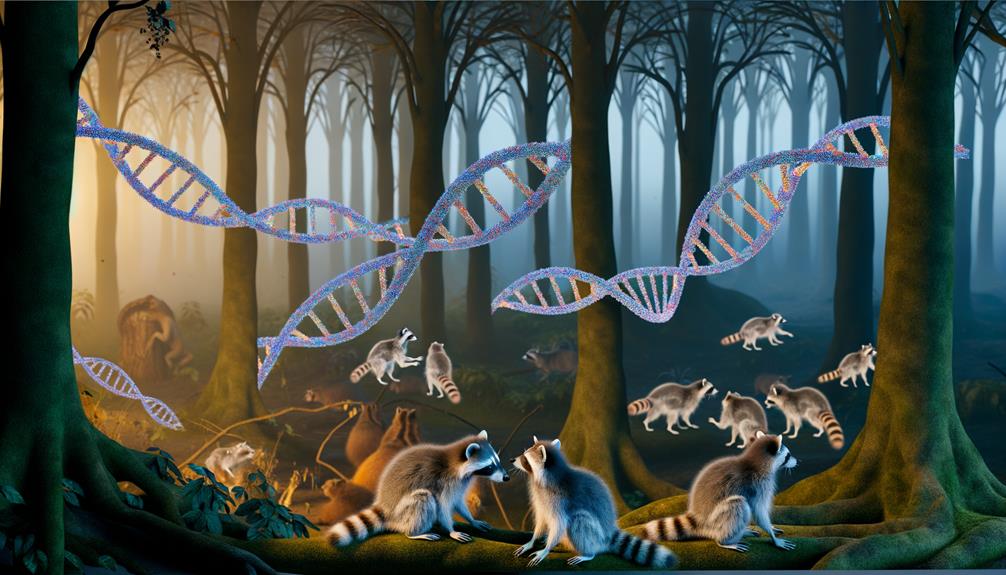
Inbreeding among raccoons can lead to a significant reduction in genetic diversity, which may compromise the population's overall resilience to environmental changes and disease.
This genetic uniformity increases the likelihood of inherited health issues, including congenital defects and reduced fertility.
Understanding the genetic implications of inbreeding is essential for evaluating the long-term viability of raccoon populations.
Genetic Diversity Reduction
When closely related raccoons mate, the resultant inbreeding can lead to a significant reduction in genetic diversity, potentially increasing the prevalence of deleterious alleles within the population.
Genetic diversity is vital for the adaptability and resilience of a species, as it allows populations to adjust to environmental changes and resist diseases.
Inbreeding reduces heterozygosity, thereby limiting the gene pool. This reduction can lead to the fixation of harmful alleles, which may otherwise be masked in a more genetically diverse population.
Consequently, a decrease in genetic variation heightens vulnerability to pathogens and environmental pressures, ultimately undermining the long-term viability of the raccoon population.
Understanding these genetic implications is necessary for wildlife management and conservation efforts.
Inherited Health Issues
The reduction in genetic diversity caused by inbreeding among raccoons can lead to a range of inherited health issues, exacerbating the population's susceptibility to congenital defects and genetic disorders.
Inbreeding heightens the risk of homozygosity for deleterious alleles, increasing the incidence of conditions such as heart defects, immune system deficiencies, and reduced fertility.
Such genetic bottlenecks can also result in decreased adaptability to environmental changes, making populations more vulnerable to diseases and habitat modifications.
Moreover, the accumulation of harmful mutations can compromise overall fitness and survival rates.
Conservation efforts should prioritize maintaining genetic diversity to mitigate these risks, ensuring the long-term viability and health of raccoon populations.
Observations in the Wild
Field studies have shown that sibling interaction patterns among raccoons can influence mating behaviors, particularly during mating season dynamics.
Observations indicate that while raccoons exhibit social structures that might reduce the likelihood of sibling mating, instances of inbreeding have been documented.
These findings highlight the complex interplay between genetic diversity factors and the natural behaviors observed in raccoon populations.
Sibling Interaction Patterns
Observations in the wild frequently reveal complex and varied interaction patterns among raccoon siblings, characterized by both cooperative and competitive behaviors. Siblings often engage in mutual grooming, play-fighting, and foraging together, which strengthens social bonds and aids in survival skills. Conversely, competition for resources such as food and shelter can lead to aggressive encounters. These behaviors are essential for understanding the social dynamics within raccoon families.
| Behavior | Frequency | Emotional Impact |
|---|---|---|
| Mutual Grooming | High | Positive Bonding |
| Play-Fighting | Moderate | Skill Development |
| Foraging Together | High | Cooperative Survival |
| Resource Competition | Moderate | Aggression |
| Aggressive Encounters | Low | Stress and Dominance |
These interactions highlight the dual nature of sibling relationships, balancing cooperation and competition.
Mating Season Dynamics
Mating season in raccoons is marked by heightened activity and distinct behavioral changes, including increased vocalizations and territorial displays. During this period, typically from late winter to early spring, males become more aggressive as they compete for access to receptive females.
Observations in the wild indicate that males may expand their home ranges and engage in frequent scent-marking to establish dominance. Females exhibit selective mating behaviors, often choosing mates based on physical fitness and territory quality. These dynamics result in brief but intense encounters, after which males typically do not contribute to parental care.
The heightened activity and territoriality during mating season underscore the complex social structures and reproductive strategies inherent in raccoon populations.
Genetic Diversity Factors
Genetic diversity in raccoon populations is influenced by various factors, including mating behaviors and environmental pressures observed in the wild. Studies have shown that raccoons exhibit both inbreeding and outbreeding tendencies, which directly impact genetic variation. Environmental factors such as habitat fragmentation and urbanization further influence these dynamics by altering raccoon movement and mating patterns.
Key factors affecting genetic diversity include:
- Mating System: Raccoons often display a polygynous mating system, which can lead to varied genetic contributions from multiple males.
- Dispersal Patterns: Juvenile dispersal reduces the likelihood of inbreeding by encouraging gene flow between populations.
- Habitat Connectivity: Connected habitats facilitate gene flow, whereas isolated habitats may increase inbreeding risks.
Understanding these factors is essential for managing raccoon populations and ensuring their genetic health.
Research Studies on Raccoon Breeding
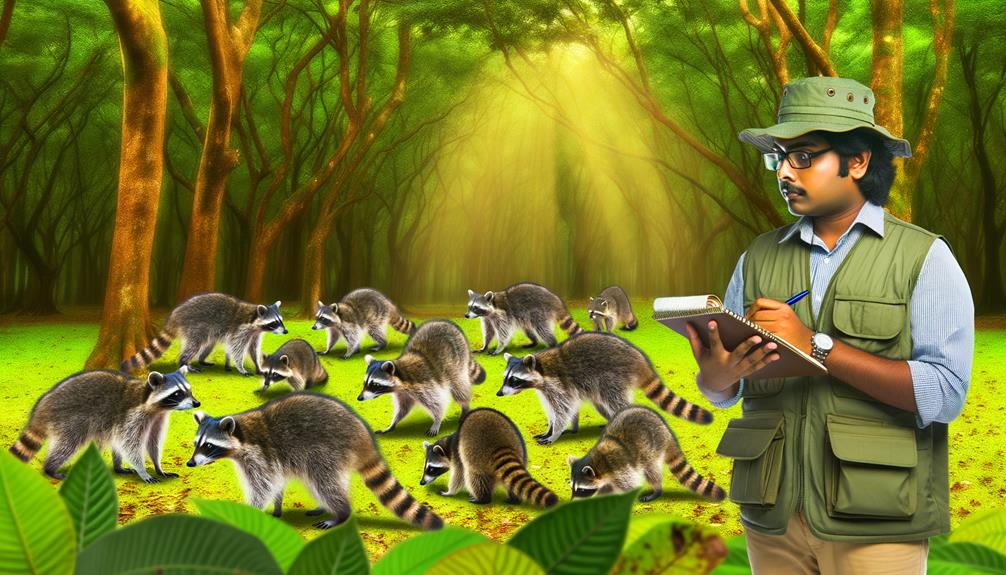
Extensive research studies on raccoon breeding behavior have provided insightful data on their mating patterns and genetic diversity. Field observations and genetic analyses indicate that raccoons typically exhibit polygynous mating systems, where one male mates with multiple females.
These studies have shown that male raccoons often travel considerable distances to find unrelated females, thereby enhancing genetic diversity within populations. DNA profiling techniques have revealed low levels of inbreeding, suggesting a natural tendency to avoid close relatives.
Additionally, seasonal variations in breeding activities have been documented, with peak mating periods occurring in late winter to early spring. This wealth of data contributes to a thorough understanding of raccoon reproductive strategies and their implications for population dynamics.
Inbreeding Prevention Mechanisms
One of the key mechanisms raccoons use to prevent inbreeding involves the dispersal behavior of juvenile males, which reduces the likelihood of mating with close relatives. This behavior is essential in maintaining genetic diversity within populations. Juvenile males typically leave their natal areas to establish their own territories, thereby minimizing the chances of inbreeding.
Additionally, several other mechanisms contribute to inbreeding prevention:
- Kin Recognition: Raccoons possess the ability to recognize kin through olfactory and auditory cues, which helps them avoid mating with close relatives.
- Female Mate Choice: Females may exhibit preferences for unrelated males, thereby further reducing the risk of inbreeding.
- Territoriality: Established territories often limit interactions between closely related individuals.
These mechanisms collectively secure genetic variability and population health.
Impact of Habitat on Mating
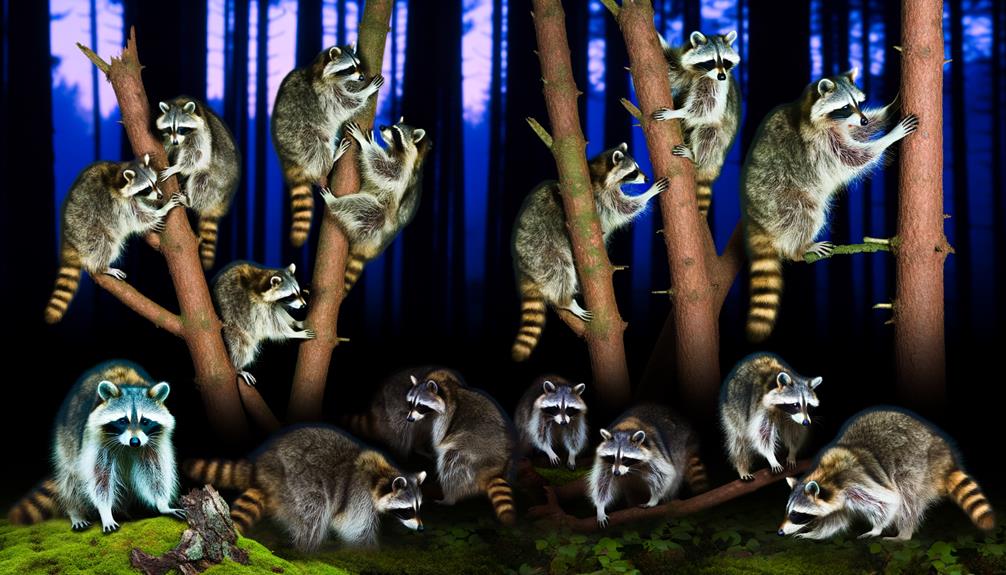
The habitat in which raccoons reside greatly influences their mating behaviors and patterns. In densely populated urban areas, limited space and resources can lead to higher instances of inbreeding due to restricted dispersal opportunities.
Conversely, in rural or forested regions, raccoons have more expansive territories, reducing the likelihood of mating with close relatives. Seasonal availability of food sources also plays a pivotal role; in areas with abundant resources, raccoons may exhibit more frequent and diverse mating interactions.
Additionally, habitat fragmentation can isolate populations, impacting genetic diversity and complicating natural inbreeding avoidance mechanisms. Understanding these habitat-driven dynamics is essential for comprehending raccoon reproductive strategies and maintaining genetic health within populations.
Human Influence on Raccoon Populations
Human activities have greatly altered raccoon populations by modifying their habitats, influencing their food availability, and introducing new environmental pressures.
Urbanization and deforestation have led to increased encounters between raccoons and humans, often resulting in raccoons adapting to urban environments. Additionally, human-generated waste provides a readily accessible food source, altering raccoon foraging behaviors and potentially increasing population densities in urban areas.
Key human influences on raccoon populations include:
- Habitat Modification: Urban development and deforestation have fragmented natural habitats.
- Food Availability: Human waste and deliberate feeding have provided new, reliable food sources.
- Environmental Pressures: Increased road traffic and pest control measures impact raccoon mortality rates.
These factors collectively shape raccoon behavior, reproduction, and survival in human-altered landscapes.
Conclusion
To sum up, while raccoons possess mechanisms to avoid inbreeding, environmental factors and human influence can disrupt these natural safeguards.
An apt metaphor is the careful dance of bees around a hive; similarly, raccoons navigate complex social structures to guarantee genetic diversity.
A study in Ontario revealed that only 3% of raccoon offspring were a result of sibling mating, highlighting the species' inherent strategies to maintain genetic health and population stability despite external pressures.



